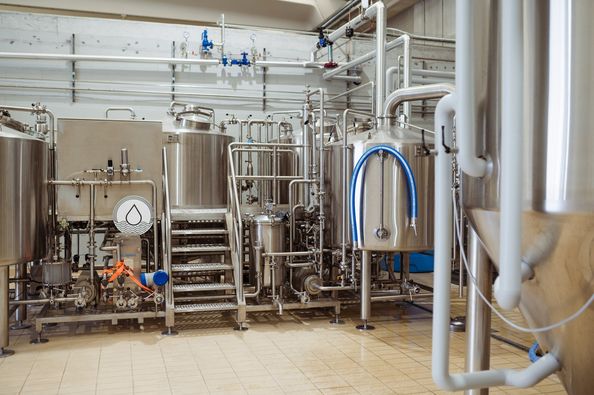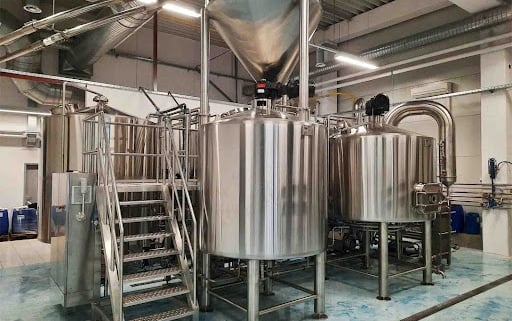Wine Making Equipment for Sale
Ever dreamed of uncorking a bottle and boasting, “I made this!”? Well, with the right wine making equipment for sale, that dream can become a reality. But wading through the plethora of options can be daunting. Fear not, aspiring vintner! This comprehensive guide will equip you with the knowledge to confidently navigate the world of wine making equipment.
Essential Wine Making Equipment
Here’s a breakdown of the key equipment you’ll need to craft your own vintage:
| Equipment | Description |
|---|---|
| Primary Fermenter | This vessel, typically a carboy or stainless steel tank, serves as your grape must’s home during fermentation. |
| Airlock | This ingenious little device allows carbon dioxide to escape while preventing unwanted contaminants from entering the fermenting must. |
| Hydrometer | This tool measures the sugar content of your grape must, crucial for monitoring the fermentation process and determining alcohol content. |
| Siphon | This handy tool allows you to effortlessly transfer your wine between containers without disturbing the sediment. |
| Carboy Caps and Grommets | These secure your airlock to the primary fermenter, creating an airtight seal. |
| Sanitizer | Maintaining a clean environment is paramount to successful wine making. Sanitizer ensures your equipment is free of bacteria and wild yeasts that can negatively impact your wine. |

Additional Equipment for Consideration
As you delve deeper into the world of wine making, you might consider investing in additional equipment to enhance your wine making experience:
| Equipment | Description |
|---|---|
| Crusher/Destemmer | This machine efficiently breaks up grapes and removes stems, a time-saving option for large batches. |
| Press | If you plan on using whole fruits besides grapes, a press will help extract juice for fermentation. |
| Secondary Fermenter | Transferring your wine to a secondary fermenter after primary fermentation allows sediment to settle and promotes clarification. |
| Bottles and Corks | The final touch! Choose aesthetically pleasing bottles and corks to showcase your homemade masterpiece. |
| Bottle Capper | A bottle capper ensures your corks are securely sealed for proper storage. |
| Refractometer | This tool provides a more precise measurement of sugar content compared to a hydrometer. |
Wine Making Process
Now that you’re armed with the essential equipment, let’s explore the basic stages of wine making:
- Crushing and Destemming: Grapes are crushed to release their juice (must), and stems are removed to avoid imparting bitterness.
- Primary Fermentation: Must is transferred to the primary fermenter, yeast is added, and the magic begins! Yeast consumes the sugar in the must, converting it into alcohol and carbon dioxide.
- Racking (Optional): After primary fermentation, transferring the wine to a secondary fermenter allows sediment to settle, resulting in a clearer final product.
- Secondary Fermentation (Optional): This stage allows the wine to mature and develop its flavor profile.
- Bottling: The wine is bottled, corked, and sealed for storage or enjoyment.
Factors to Consider When Choosing Wine Making Equipment
Selecting the right equipment boils down to a few key considerations:
- Wine Making Volume: How much wine do you plan on making per batch? This will determine the size of your primary fermenter and other equipment.
- Budget: Wine making equipment ranges from affordable starter kits to high-end professional models. Determine your budget and choose equipment that offers the features you need at a price point you’re comfortable with.
- Experience Level: Are you a complete novice or a seasoned vintner? Beginner kits offer a user-friendly approach, while experienced wine makers may require more specialized equipment.
- Desired Features: Do you crave complete automation or prefer a more hands-on approach? Consider features like temperature control or automatic racking systems.
Wine Making Equipment Suppliers and Price Range
Here’s a glimpse into some popular suppliers of wine making equipment and their pricing ranges:
| Supplier | Price Range (USD) |
|---|---|
| Northern Brewer | $20 – $1,000+ |
| Midwest Supplies | $50 – $900+ |
| Eastern Winery Supply | $30 – $2,000+ |
| Homebrew Shops (Local) | Prices vary depending on |
Wine Making Equipment for Sale: Installation, Operation, and Maintenance
Equipping yourself with the knowledge to install, operate, and maintain your wine making equipment is crucial for a successful wine making experience. Here’s a breakdown of these essential aspects:
Installation:
- Sanitization is Key: Before using any new equipment, thoroughly sanitize it according to the manufacturer’s instructions. This eliminates any potential contaminants that could spoil your wine.
- Assembly: Most equipment comes with user manuals that detail the assembly process. Carefully follow the instructions to ensure proper functionality.
- Space Considerations: Allocate adequate space for your equipment. Ensure easy access for cleaning, maintenance, and maneuvering during the wine making process.
Operation:
- Read the Manual: Each piece of equipment has its own quirks and functionalities. Investing time in understanding the user manual will prevent misuse and ensure optimal performance.
- Temperature Control: Temperature plays a vital role in fermentation. Some equipment, like temperature-controlled fermenters, simplifies this aspect, while others require close monitoring with an external thermometer.
- Following Recipes: Wine making recipes, readily available online or in wine making books, provide detailed instructions on using specific equipment for each stage of the process.
Maintenance:
- Cleaning: Regular cleaning of your equipment is vital to prevent the growth of bacteria and wild yeasts that can negatively impact your wine. Clean your equipment thoroughly after each use with a no-rinse sanitizer or a solution of warm water and a mild cleanser.
- Storage: When not in use, store your equipment in a clean, dry place. Proper storage prevents rust, warping, and ensures your equipment is ready for your next wine making adventure.
Choosing the Right Wine Making Equipment Supplier
Selecting the right supplier for your wine making equipment involves a few key factors:
- Reputation: Research the supplier’s reputation for quality products, customer service, and competitive pricing. Online reviews and forums can be valuable sources of information.
- Selection: Does the supplier offer a wide variety of equipment to suit your needs and experience level? Consider whether they carry specific brands or specialize in particular wine making styles.
- Customer Service: A reliable supplier with knowledgeable and responsive customer service can answer your questions and provide valuable guidance throughout your wine making journey.
- Shipping: Factor in shipping costs and delivery timelines when comparing suppliers.
Table: How to Choose a Wine Making Equipment Supplier
| Factor | Description |
|---|---|
| Reputation | Research online reviews, forums, and industry publications to assess the supplier’s credibility and customer satisfaction ratings. |
| Selection | Consider the variety of equipment offered, including brands, types, and suitability for your needs. |
| Customer Service | Look for a supplier with knowledgeable staff who can answer your questions and offer support. |
| Shipping | Factor in shipping costs, delivery timelines, and any return policies before finalizing your purchase. |
Wine Making Equipment: Pros and Cons
Table: Wine Making Equipment: Pros and Cons
| Equipment | Pros | Cons |
|---|---|---|
| Starter Kits | Affordable, user-friendly, includes essential equipment to get started. | May lack advanced features, limited capacity for larger batches. |
| Stainless Steel Tanks | Durable, easy to clean, allows for temperature control (with additional equipment). | More expensive than carboys, require more storage space. |
| Carboys | Affordable, lightweight, easy to find and replace. | Can be fragile, prone to scratches, limited temperature control options. |
| Crusher/Destemmer | Saves time and effort for processing large batches of grapes. | Adds another piece of equipment to clean and store, may not be necessary for small batches. |
| Press | Extracts juice from various fruits for fermentation, expanding your wine making repertoire. | Additional equipment to purchase and maintain, may not be suitable for all wine making styles. |
Beyond the table, here are some additional considerations:
- Stainless steel tanks offer a more professional feel and greater durability compared to carboys. However, they come at a higher price point and require more storage space.
- A crusher/destemmer is a time-saving investment for large batches, but for smaller endeavors, manual destemming might suffice.
- A press opens doors to experimenting with various fruits besides grapes, but factor in the additional cost and storage requirements.

FAQ
| Question | Answer |
|---|---|
| What is the best type of primary fermenter? | The best choice depends on your budget, experience level, and desired batch size. Here’s a breakdown: * Stainless steel tanks: Durable, easy to clean, allows for temperature control (with additional equipment). Ideal for serious wine makers or those who value precision. * Carboys: Affordable, lightweight, easy to find and replace. A good option for beginners or small batch wine making. Consider factors like space constraints and desired features when making your choice. |
| Do I need a crusher/destemmer? | Not necessarily. Crusher/destemmers are time-saving for large batches. Here’s a breakdown: * For large batches: A crusher/destemmer saves time and effort. * For small batches: Manual destemming with a food processor or by hand is an option. The decision depends on your batch size and preference for efficiency. |
| What are the different types of filtration systems? | There are various filtration systems, each with its pros and cons: * Plate and frame filters: Effective for large batches but require more setup and cleaning. * Depth filters (cartridge filters): Disposable and user-friendly for smaller batches, but may not be as efficient for larger volumes. * Vacuum filters: Efficient for clarifying wine, but require a vacuum pump and can be more expensive. Research the different options to find the one that best suits your needs. |
| Is bottling line equipment necessary? | Bottling line equipment is ideal for large-scale operations, but not essential for home wine makers. Here’s a breakdown: * For large batches: Bottling line equipment (rinser, filler, corker, capsule setter) saves time and streamlines the process. * For small batches: Manual bottling with a hand corker and capsule setter is sufficient. Consider your batch size and desired level of automation before investing in bottling line equipment. |
| Should I start with manual or automated equipment? | The choice depends on your preferences and budget: * Manual equipment: More affordable, hands-on experience, greater control over the process. Ideal for beginners or those who enjoy a more involved approach. * Automated equipment: Saves time and effort, simplifies the process, often includes features like temperature control. A good option for those who value convenience or have larger batch sizes. Ultimately, the choice is yours! |
| Where can I find recipes for using wine making equipment? | Numerous resources offer wine making recipes that detail equipment usage for each stage. Here are a few options: * Online wine making websites and forums: Many websites offer free recipes specifically designed for home wine makers. * Wine making books: There are many excellent wine making books available that provide detailed recipes and equipment instructions. * Wine making supply stores: These stores often have recipe kits or recipe resources available for their customers. |
| How do I clean and maintain my wine making equipment? | Proper cleaning and maintenance are crucial for successful wine making. Here’s a basic guideline: * Cleaning: After each use, thoroughly clean your equipment with a no-rinse sanitizer or a solution of warm water and a mild cleanser. * Storage: Store your equipment in a clean, dry place to prevent rust or warping. Most equipment manuals will provide specific cleaning and storage instructions. |













